Two Nerdy History Girls
Bestselling authors Loretta Chase & Susan Holloway Scott gossip about history, writing, and yes, shoes.

Tuesday, August 9, 2011
A place for everything: a victorian lady's traveling case, c. 1870.

9 comments:
Oh, I love the pictures and I also love the idea. Some people are so lucky to have such things kept through the generations.
I love it too. Partially it is extremely useful to have mirrors, nail files and scissors, brushes and combs etc on hand. But also because it shows that just because an object is useful, it doesn't have to look like rubbish. The cut glass with engraved silver lids are to die for, as is the large engraved silver box itself. My bathroom drawer looks like a rubbish bin, full of plastic bits :(
Ooh I want one of those. Of course there are a few things I'll have to pick up to put in the drawers, but at least I'd have that gorgeous case.
Whenever I see something like that in an antique store, I feel an overwhelming urge to posses it. Sadly, they’re always WAY above my means, LOL!
Now that is amazing.I totally want one too! But can you imagine being the poor ladys maid who had to look after all those little hooks and bottles and lids? I'm always loosing stuff like that in hotels, but it's just plastic. If you lost one of milady's crystal bottles of shampoo, you'd get the sack.
I agree with La Donna: I want one. This is a great picture and post. One of my books takes place in Victorian London. If Mama goes traveling, now I know what she takes. (It may be a series.). You really come up with such good information on this blog. Thanks for sharing.
Beautiful! I agree with Shannon; it's wonderful that it has been kept by the family. It is so indicative of changing technology and the change in women's lives. ...and yes to LaDonna, the poor maid. Thanks to the reader who let you post this!
I really enjoyed this post-thank you. I have an identical box but sadly without the beautiful and amazing contents it feels to be a ghost of it's former self.It was made by or sold by Leuchars of Piccadily -and has three brass initials on it. EPG I think to be Lady Edith Payne Gallwey who married in 1871 Sir William Payne Gallwey 2nd baronet 1807 MP for Thirsk in Yorkshire. Inherited from my grandmother who made frocks for presentation of debs at court -guess she was given it by one.
I love necessaires like this. Marinni is a real treasure trove for things of that sort, I love her posts c: .
Post a Comment
A Polite Explanation

Susan's Latest

- "Accessories: Head to Toe" (9)
- "Among His Troops" (1)
- "Colorful Folk" needlework (1)
- "Cosmopolitan Consumption" (3)
- "Embroidery: The Language of Art" (3)
- "Embroidery: The Thread of History" (1)
- "Fashion Unraveled" (1)
- "Fashioning the New England Family" (2)
- "Immortal Beauty" (2)
- "Philadelphia in Style" (1)
- "Printed Fashions" (5)
- "The Diligent Needle" (3)
- "Visitors at Versailles" (1)
- "Visitors to Versailles" (3)
- 17th century (3)
- 18th century (50)
- 19th century (35)
- 19thcentury (1)
- 20th century (123)
- Abigail Adams (2)
- Abject Apologies (15)
- accessories (7)
- African Americans (3)
- Albania (2)
- Alexander Hamilton (31)
- amazing places (130)
- American Philosophical Society (1)
- American Revolution (41)
- American Textile History Museum (3)
- ancient world (6)
- animals (9)
- appearances (4)
- architecture (85)
- art "Among His Troops" (1)
- Art Museums of Colonial Williamsburg (8)
- automaton (10)
- bathing (22)
- beauty (27)
- beauty aids (41)
- books (310)
- Bostonian Society (5)
- Brandywine (3)
- breakfast links (351)
- caricature (157)
- carriages (32)
- Casual Friday (74)
- celebrities (23)
- cemeteries (3)
- Charles II (30)
- Charles Willson Peale (1)
- Charlotte Bronte (1)
- Chester County HIstorical Society (3)
- children (35)
- Christmas (39)
- Christmas in CW (33)
- Civil War (11)
- coaching (14)
- Colonial America (60)
- Colonial Williamsburg (290)
- corsets (37)
- costumes (7)
- country houses (6)
- crime & the law (15)
- CSA 2018 Symposium (1)
- customs and traditions (68)
- dandies (3)
- death & mourning (22)
- decorative arts (20)
- Dickens (15)
- Downton Abbey (14)
- Downton Abbey history (13)
- drawings (5)
- early America (7)
- education (23)
- Edwardians (22)
- Eliza Hamilton (38)
- embroidery (38)
- exhibitions (44)
- fashion (526)
- fashion history (227)
- Federal America (10)
- First Bank of the US (1)
- flowers (3)
- Fox Historic Costume Collection (4)
- Friday videos (219)
- furnishings (117)
- gardens (42)
- George II (4)
- George III (9)
- George IV (45)
- George Washington (5)
- Georgian England (163)
- Gilded Age (5)
- Gone Fishin' (9)
- Grand Tour (1)
- Hampton Court Palace (4)
- Heritage Museums & Gardens (7)
- Historic Deerfield (3)
- historic dress (617)
- historic trades (50)
- Historical Society of Pennsylvania (1)
- history (935)
- holidays (99)
- horses (26)
- Houghton Library (5)
- housekeeping mysteries (44)
- interesting objects (257)
- interesting people (55)
- intrepid women (119)
- Isabella Bradford/Susan Holloway Scott (800)
- Jane Austen (31)
- jewelry (54)
- Joyful Announcements (25)
- knitting (4)
- language mysteries (57)
- letters (6)
- libraries (12)
- Litchfield Historical Society (1)
- locations (157)
- London (104)
- London Transport Museum (3)
- Loretta Chase (1089)
- love letter (3)
- manners (60)
- Marie Antoinette (10)
- Massachusetts Historical Society (8)
- medical matters (49)
- men behaving badly (103)
- Metropolitan Museum of Art (32)
- millinery (6)
- money matters (2)
- movies (33)
- Museum at FIT (6)
- Museum of Fine Arts (6)
- Museum of London (5)
- Museum of the American Revolution (12)
- museums (36)
- musical instruments (3)
- Napoleon (2)
- Napoleonic Wars (12)
- Native Americans (5)
- needlework (39)
- new books (16)
- New York City (2)
- NHG library (44)
- Notorious History (54)
- NY Historical Society (2)
- occupations (53)
- Old Sturbridge Village (3)
- paintings (16)
- paranormal mysteries (6)
- peerage (11)
- performers (12)
- Philadelphia Museum of Art (4)
- photographs (13)
- poetry (26)
- porcelain (1)
- portraits (121)
- Pottsgrove Manor (3)
- prints (257)
- Queen Victoria (29)
- quotations (292)
- real heroes (36)
- recipes (3)
- Regency & Romantic eras (202)
- religion (1)
- RISDMuseum (9)
- royalty (67)
- Schuyler Mansion (5)
- scientific marvels (47)
- servants (23)
- seventeenth century (5)
- Shakespeare (2)
- Shameless Self-Promotion (106)
- silly videos (46)
- Smithsonian (3)
- sports (16)
- Strawbery Banke (6)
- Suffragists (7)
- Susan Holloway Scott (716)
- television and video (136)
- Ten Broeck Mansion (1)
- textiles (6)
- the Oaks (5)
- theater (3)
- transportation (9)
- travel (58)
- Tudor Place (1)
- Tudors (18)
- Twitter (6)
- U.S. history (37)
- uniforms (5)
- V&A museum (8)
- Valley Forge (1)
- Versailles (3)
- Victorian era (113)
- Virginia Museum of Fine Arts (8)
- weapons (2)
- weather (8)
- weddings and marriage (46)
- William and Mary (6)
- William IV (5)
- Winterthur (56)
- Worcester Art Museum (1)
- Worcester Historical Museum (1)
- words of wisdom (14)
- writers (25)
- writing life (1)
Loretta's Latest

Blog Archive
- ► December (11)
- ► November (15)
- ► October (20)
- ► September (14)
- ► August (16)
- ► July (17)
- ► June (18)
- ► May (23)
- ► April (16)
- ► March (19)
- ► February (19)
- ► January (19)
- ► December (14)
- ► November (14)
- ► October (23)
- ► September (16)
- ► August (18)
- ► July (14)
- ► June (22)
- ► May (21)
- ► April (21)
- ► March (21)
- ► February (12)
- ► January (2)
- ► December (9)
- ► November (13)
- ► October (22)
- ► August (19)
- ► April (22)
- ► March (22)
- ► February (21)
- ► January (20)
- ► December (17)
- ► November (20)
- ► October (27)
- ► September (21)
- ► July (27)
- ► June (25)
- ► May (28)
- ► April (23)
- ► March (27)
- ► February (24)
- ► January (28)
- ► December (19)
- ► November (21)
- ► October (26)
- ► September (25)
- ► August (13)
- ► July (26)
- ► June (24)
- ► May (16)
- ► April (26)
- ► February (25)
- ► January (26)
- ► December (15)
- ► September (26)
- ► August (21)
- ► July (22)
- ► March (26)
- ► November (24)
- ► October (31)
- ► August (26)
- ► June (27)
- ► May (30)
- ► February (26)
- ► January (27)
- ► December (25)
- ► October (32)
- ► September (27)
- Happy Second Anniversary to Us (plus More About Th...
- They do it differently in France Part Deux*
- We had this hurricane
- The amazing singing bird pistols
- Politics & the Staymaker: Thomas Paine, 1793
- The New Moon Motor Car for 1917
- The Horned Helmet of Henry VIII, 1514
- Richard Brinsley Sheridan, Georgian Gentleman
- Breakfast Links: Week of August 15, 2011
- Friday Video Clip: Georgian-Style Seduction from "...
- Fashions for August 1816
- How to Lace Your Stays by Yourself, c. 1770
- An elegant vehicle for August 1820
- A Birthday Ride in an 18th c. Carriage
- Breakfast Links: Week of August 8, 2011
- Royal loos through time
- Tight Lacing for Ordinary Women, c. 1777
- King William's private place
- A Place for Everything: A Victorian Lady's Traveli...
- Fashions for August 1831
- Breakfast Links: Week of August 1, 2011
- The Last Living Witness to the Lincoln Assassinati...
- A Gothic Dairy
- A Bride with Wedding Night Jitters, c. 1750
- A Lady's Nécessaire
- ► June (28)
- ► May (26)
- ► April (28)
- ► March (29)
- ► December (26)
- ► October (24)
- ► August (25)
- ► July (25)
- ► June (23)
- ► May (24)
- ► April (20)
- ► January (30)
- ► December (22)
- ► November (23)
- ► October (18)
- ► August (12)
- ► July (2)
- ► June (3)
Search This Blog
Sites we visit.
- BBC British Paintings On-Line
- Bata Shoe Museum
- Boston Athenaeum Digital Collections
- British Art at Yale University
- British History Online
- Chateau de Versailles
- Chawton House
- Colonial Williamsburg Foundation
- Common-Place History Magazine
- Country House Database UK
- Country vs. City: Renaissance Food
- Drexel Digital Museum Project Historic Costume Collection
- Emily P. Reynolds Historic Costume Collection
- Europeana Fashion portal
- FIDM Museum & Galleries
- Fashion History Museum
- Fashion Museum of Bath
- Geffrye Museum of London
- Getty Collections
- Getty Images & Hulton Archives
- Hermitage Amsterdam
- Historic New England Collections
- Historical Foods
- Historical Novelists Society
- Historical Novels Review
- History Today
- LACMA Image Library
- Lewis Walpole Library, Yale University
- London Ancestor
- Love's Guide to the Church Bells of the City of London
- Metropolitan Museum of Art
- Museum at FIT
- Museum of Childhood
- National Library of Medicine:History of Medicine
- National Portrait Gallery UK
- National Portrait Gallery US
- Old London Maps
- Old Sturbridge Village
- Philadelphia Museum of Art
- Pockets of History
- RISD Museum of Art
- School of Historical Dress
- Solander Magazine
- The Book of Days
- The British Library
- The British Museum
- The Royal Collections
- University of Edinburgh Image Collections
- Victoria & Albert Museum
- Vintage Textiles
- Vintage Vogue
Blogs We Follow
Tumblrs we like.
- 18th Century Love
- Andy Marshall/Churches Conservation Trust
- Chicago History in Pictures
- Hark! A Vagrant
- My Daguerreotype Boyfriend
- OMG...Cravats
- Questionable Advice & Advertisements
- Rococo Revisited
- Smithsonian Libraries
- Super Seventies
- The Charleston Museum
- The Cult of Genius
- The Daily Victorian
- The Lively Morgue
- The Swinging Sixties
- The Victorianist
- Things Organized Neatly
- Tousled & Tumbl'd
- Tuesday Johnson
- Victorian Secret
- Writers at Work
Problem with this page?
You can contact us with the problem you are having and we will investigate., sending report... please wait , thank you ... we have received your message. our team will investigate the problem.

Stripe Online Payments
Sellingantiques have now partnered with stripe card processing to give you a seamless purchase experience of antiques on sellingantiques. millions of companies of all sizes use stripe online to accept payments and is the worlds no.1 payment gateway. so how does it work: look for the button in the antique details page to instantly purchase antiques from dealers who have activated stripe online payments. purchase antique you can now easily filter and show antiques that only have this option enabled. using this button notifies us immediately that you have purchased this item. once you have made the payment we will instantly mark it as sold to ensure that no one else can buy it. discounts can also be made available. we are always improving the purchase experience for both buyer and seller and more and more dealers are enabling this option each week..

- Categories by photo
- The Antiques Dealers

Antique Travel Case

- All Antiques 75,000
- Antique Leather Travel 27
- Antique Travel Box 34
- Antique Travel Case 30
- Antique Travel Chests 51
- Antique Travel Silver 26
- Antique Travel Trunks 42
- Antique Travelling Travel 158
- Antiques Under £100 1,119
- SOLD Antiques 616,517
Dealers with the most listings for Antique Travel Case
- London Fine Antiques 12
- Gutlin Clocks 2
- Roger Bradbury Antiques 2
- Unique Antiques by Emma Jade 2
- Gerard Robinson Fine Art and Antiques 1
Your comment has been sent to Sellingantiques.
Your rating and comment have been sent to sellingantiques., your score has been recieved., thanks. but what can we do better, if you would like to be contacted to discuss your feedback then please leave a phone number or email address in your message., thanks for your great feedback, we love it when our wonderful visitors are happy with us, live daily database information for 29 june 2024.

- Скидки дня
- Справка и помощь
- Адрес доставки Идет загрузка... Ошибка: повторите попытку ОК
- Продажи
- Список отслеживания Развернуть список отслеживаемых товаров Идет загрузка... Войдите в систему , чтобы просмотреть свои сведения о пользователе
- Краткий обзор
- Недавно просмотренные
- Ставки/предложения
- Список отслеживания
- История покупок
- Купить опять
- Объявления о товарах
- Сохраненные запросы поиска
- Сохраненные продавцы
- Сообщения
- Уведомление
- Развернуть корзину Идет загрузка... Произошла ошибка. Чтобы узнать подробнее, посмотрите корзину.
Antique Touring Hat Box, French, Leather, Brass, Travel Case, Victorian, C.1850
View similar items.

- Item Details
- Seller Information
About the Item
- Dimensions : Height: 13.98 in (35.5 cm) Width: 14.77 in (37.5 cm) Depth: 13.59 in (34.5 cm)
- Materials and Techniques : Leather
- Place of Origin : United Kingdom
- Period : Mid-19th Century
- Date of Manufacture : circa 1850
- Condition : Good Wear consistent with age and use. Presented in very good antique condition.
- Seller Location : Hele, Devon, GB
- Reference Number : Seller: 18.8403 1stDibs: LU2645329077222

Antique Mid-19th Century British Early Victorian Jewelry Boxes
Wood, Cedar
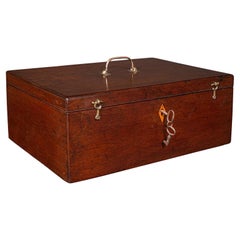
Antique Travelling Jewellery Salesman's Box, English Carry Case, Victorian, 1850
Antique 1890s chinese chinoiserie jewelry boxes.
Pine, Lacquer
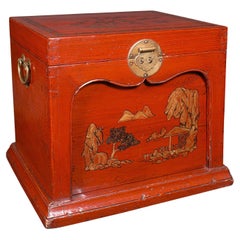
Antique Travelling Jewellery Box, Chinese, Lacquered, Campaign Case, Victorian
Antique 1850s british early victorian jewelry boxes.
Glass, Wood
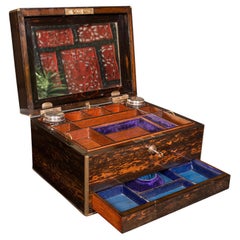
Antique Travelling Vanity Case, English, Coromandel, Jewellery Box, Victorian
Antique late 19th century british decorative boxes.
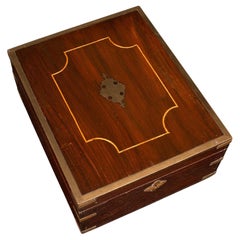
Antique Gentleman's Travelling Box, Anglo Indian, Correspondence Case, Victorian
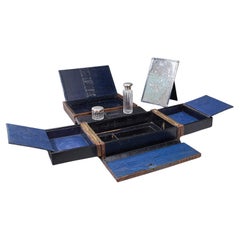
Antique Travelling Vanity Box, English, Campaign Correspondence Case, Victorian
Antique late 19th century chinese chinese export decorative boxes.

Antique Cleric's Swing Out Case, Chinese, Travelling Box, Qing, Victorian, 1890
Antique 1850s english victorian sterling silver.
Silver, Sterling Silver
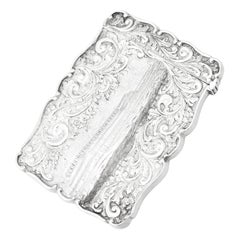
Antique 1850 Victorian Sterling Silver Card Case
Early 20th century english late victorian decorative boxes.
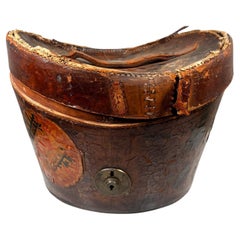
1900s Antique Victorian Leather Hat Box Baggage S Moss Toronto
Antique 19th century english victorian decorative boxes.
Silk, Leather
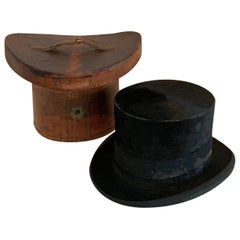
Victorian Beaver Silk Top Hat with Custom Leather Hat Box
Early 20th century art deco decorative boxes.

Leather Hat Box, Travel Trunk with Original Stickers, 1920s
Antique 1860s english decorative boxes.
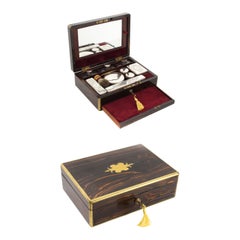
Antique Victorian Coromandel Gentleman's Travelling Vanity Case 19th C
Antique 1880s victorian decorative boxes.
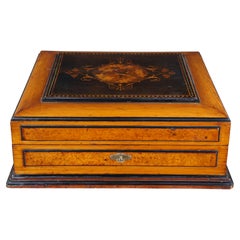
Antique French Victorian Burled Marquetry Inlay Trinket Vanity Case Cigar Box
Recently viewed, more ways to browse.
Sew Historically
Live a sustainable life, victorian and edwardian traveling and traveling costumes.
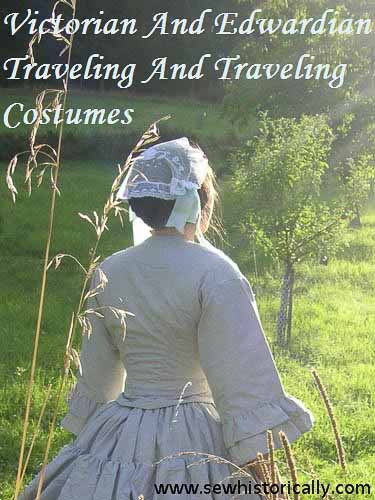
Traveling costumes were simple, warm and practical in the Victorian and Edwardian era. Beige colors were worn for travels by coach, while dark dresses were worn on sea voyages.
About Victorian and Edwardian Traveling Costumes
1859 traveling dress: ‘Straw hat plainly trimmed with ribbon. Dress of the thinner species of poplin, or any desired material. If preferred, the sleeves may be flowing, being cut to match the design, with gauntlets. The skirt is single.’ Drawing of this traveling dress. Beige or natural-colored clothing was recommended for travels by coach to hide the dust of streets.
( 1860s natural-colored linen dress )

A traveling dress in 1852 should be cut like a morning gown with a round waist (without the point in front). The skirt is made with strings underneath so that it may be looped up . The traveling costume also comprises: a corresponding collar and engageantes, a full wool mantle, dark suede gloves (iron grey, maroon, or olive is suitable), and brown, button up, thin leather boots with low heels. The bonnet is made of straw and taffeta with Cambrai lace veil for the face. An elastic traveling corset, the nonchalante, should be worn. ( Harper’s New Monthly Magazine, 1852 )
( 1860s beige wool walking dress )
In 1909 : a ‘Traveling costume should be simple in style and quiet in color, materials that will not show dirt being preferable. A waterproof cloak is a very desirable addition, as it may be at any time suddenly needed. In summer travel a long linen duster, belted at the waist, should be worn over the dress. For the country or sea-side, simple and inexpensive dresses should be provided for ordinary wear.’ ( Household Companion: Book Of Etiquette, 1909 )
( Victorian oiled silk raincoat )
Hints on Crossing the Sea in the 1850s ( Miss Leslie’s New Receipts For Cooking, 1852 )
‘The most usual voyage made by American ladies is across the Atlantic; and the time chosen for that voyage is generally in the spring or autumn’. A winter passage is usually avoided by ladies. If a lady can afford it, she should pay the additional costs for a whole room for herself so that she has additional space and privacy: ‘No one who has not been at sea can imagine the perpetual and mutual annoyance, of being confined to the small limits of a state-room with a stranger; each incommoding the other all the time, and each feeling herself under the continual surveillance of her companion; both expected to make incessant sacrifices to the convenience of each other, and perhaps only one of them having a disposition to submit to these sacrifices; in which case she that is the most amiable is always the sufferer.’
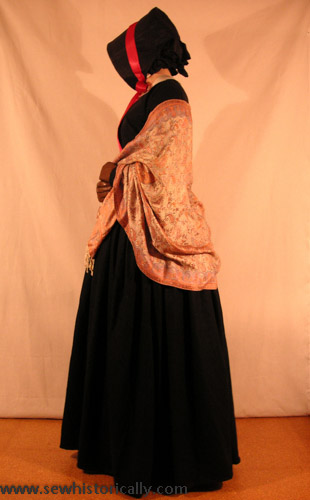
Pack away all light-colored and white dresses ; wear dark dresses which need no washing: ‘As ladies can have no washing done at sea, it will be well to begin with such dresses as can be worn all the passage. French silks are not good sea dresses, (even when black,) for the salt-air shrivels, spots, and turns them rusty. Dark-coloured india silks, or dark mousse-lines de laine, or merinoes, are much better. Dark chintzes, with no white in the figure, are convenient for common wear, at sea as well as on shore.’ Also don’t wear quilled or pleated frills on your muslin or bobbinet collar because they lose the starch in the damp see air. You may substitute your collars with silk neckerchiefs or shawls, white is best. ‘Or you may wear a broad, thick white ribbon, shaped with three diminishing pleats, to fit in closely the back of the neck, and crossed in front.’ Wear simple day caps , lined with silk, with or without a gathered border, and satin ribbons instead of gauze ones. On rough days, it is ‘impossible to arrange the hair nicely’, so the hair should be covered completely.
Take enough warm clothing with you: ‘It is colder at sea than on shore; and even in summer, the atmosphere of the Atlantic is liable to be chilled for several days by the vicinity of floating icebergs, – even when these icebergs are not seen.’ Sometimes, the clothing is the only source of heat to be had. Especially on windy weather and when the sea is rough, a fire can’t be lighted in the cabin. Therefore, flannel underwear, a large woolen shawl, warm gloves, and a wadded coat of India silk, which won’t stain, are important. Your dresses should all fasten in front because a lady has most often to dress herself, and wrappers are now made ‘universially becoming’. Don’t change your clothing during the day, as ‘dressing on ship-board is always more or less troublesome and inconvenient’. Instead of a corset , wear a flannel, lined silk, or jeans bodice without whalebone stiffening. Wear a dark linen, silk, or worsted petticoat, or a wadded silk petticoat. Also pack ‘a pair of slightly-wadded silk inside-sleeves, to be tied in beneath your gown-sleeves in chilly weather. For this purpose, have four tapes sewed to the top of each sleeve, at equal distances, and four corresponding tapes sewed to the inside of each arm-hole of your gowns.’ Stockings should be of unbleached or dark cotton, shoes should be easy to put on – without lacing or button closure – with thin soles, such as moccasins. Better than the usual cork insole are sheep-skin soles ‘coated on the under side with india-rubber varnish’. The bonnet should have a ‘deep, close front’ to screen the complexion from sunrays, and be made with ‘wired-satin piping-cord’ instead of cane or whalebone which is ‘apt to break’ in strong winds.
‘However pleasant you may find it to stay on deck, it is best, as soon as you get on board, to go to your stateroom, and make your arrangements there, lest you should be rendered incapable of doing so by the approach of seasickness’ . Take as a preventative or early remedy for seasickness some sugar with brandy. ‘For the first two days you need take no nourishment but chicken-water. Avoid lemonade, oranges, all other acids, and every sort of warm drink. Be careful, while you are sick, not to taste any thing that you may like to eat afterwards, as it will give you a disgust to it during the remainder of the voyage.’ Also don’t use perfume, such as eau de cologne, but you may sprinkle some camphor over your bed. ‘The third day (if not before) you ought to make every possible exertion to go on deck, as you will be losing strength by remaining in bed; and as long as you keep your head in a recumbent posture, you will not become accustomed to the motion of the vessel. Also, on the third day, endeavour to eat a small portion of solid, relishing food’.
Other useful travel accessories are ‘a clay-ball for the removal of grease spots […] as, when the ship is rolling, greasy substances are frequently spilt on dresses; and a life vest ‘ in case of being wrecked in sight of land’. It’s also beneficial to learn to swim before the sea voyage. Because a sea journey can be long and monotonous take plenty of interesting occupation with you: needle work, an amusing book, a journal, or write a ‘diary-letter’ to your family or friends.
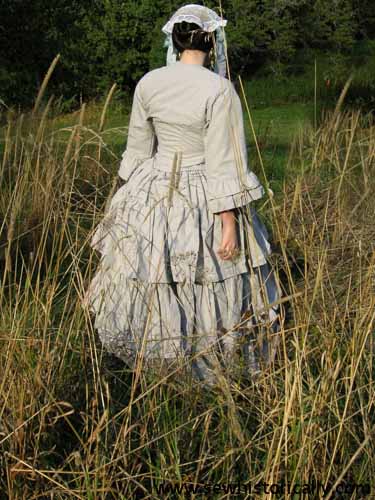
Tropical Sea Voyage ( San Francisco Call, 1905 )
‘Sailor suits are almost always pretty and becoming, and just the thing to wear on an ocean steamer running through the tropics.’ A sailor suit ‘is of duck and so made as to draw over the head like a sweater, and it can be worn either with or without the little vest. The skirt is quite short, which is not only proper but necessary on board a steamer.
The sailor hat worn with this suit is very pretty, and serves a good purpose as a sunshade, but when the ocean breezes blow, then this hat must be securely “lashed” to some part of the wearer’s “rigging.” Caps are much preferable to hats on board a steamer, and much more comfortable, but they seem to have gone out of fashion entirely.
Even this sailor suit of duck will be found to be too warm as the steamer gets into the tropical zone, and is about to “cross the line.” Some thinner material must be substituted for it – something that is more gauzy, that the air can penetrate, and for this purpose organdie is perhaps as cool as anything, and certainly as pretty. Some very pretty women can be seen on a Tahitian steamer, prettily and becomingly dressed in organdies, dimities or mulls, which makes the deck look very gay and attractive. This is a very different appearance from a bleak Atlantic liner, whose passengers are bundled up in coats and steamer rugs, and sit round on deck looking cold and cheerless. […] a very pretty organdie dress, made with a great deal of lace and insertion. […]
Underclothes have to be considered, and they must be of the thinnest possible material. Flannel is hardly to be thought of, but the lightweight linen mesh may prove to be a good substitute for it, with a fine light chemise over it.
A very nice material for a gown in the tropics is net. It is cooler than organdie, even, and is more dressy. […] a very pretty white net gown […] lined with silk of the softest variety and prettily made with insertion and shirrings. […] Of course, these net gowns are hardly appropriate for steamer wear, but they are just the thing after the steamer reaches Tahiti, and the passengers are on shore. […] one’s dress must be very light and cool and simple, still it may be pretty and becoming.
Gloves are, of course, out of the question, but light mitts can be worn to prevent the hands from being browned “to a turn.” In Paris, mitts have been all the style this year […] The handsomest of them are netted by hand of fine twist, and there are both black and white real duchess and point lace mitts, and there are also openwork silk mitts in colors to match any gown.
A particularly necessary adjunct in the tropics is a parasol, more especially now that hats are being reduced to such small proportions […] There is the smart coaching parasol with the club handle, or the dainty lingerie parasol, that goes so well and looks so attractive with the lingerie hat. […] those that have the coolest appearance, are made of white taffeta. White is said to be the best color for absorbing the heat rays of the sun. The helmet hats of Indian and African English travelers are always white, though some of them are adorned with a loose green band around the base. A parasol of pale mignonette green moire, trimmed with frills of narrow lace on the border and on top […] one made of white taffeta, with a hand painted trailing design of water lilies, and their long green stems. […]
A dress that can be worn both on the steamer and on shore at the island is a white pique, linen or duck skirt, with a shirtwaist of cool lawn, especially when a lingerie hat and parasol are added. It is a costume dressy enough for afternoon tea. […]
The lingerie hat is the best to wear in the tropics. It is light and cool, and looks cool’. One ‘made of blue chiffon and ecru lace’ or an ’embroidered linen one’.
About Carpet Bags and Packing ( The Workwoman’s Guide, 1840 )
‘Carpet bags should be purchased with large gores at the sides, as when thus made, they contain many more articles, and more conveniently than when they are only two plain pieces of carpet. They should also have a brass plate. […] every bag should have two locks […]
Here are instructions for making a travel bag .
When the party sleep several nights on the road, it is advisable to have a large carpet bag containing the night-dress of each individual packed up in night-gown bags, dressing tidies (see Plate 24), marked with the initials of the persons; by this means much trouble is saved. It is a good plan to sew a camphor bag in the night-gown to prevent the attack of fleas and bugs.
Here are instructions for making a nightgown bag for travelling .
In packing observe the following general rules: –
First, divide the light things from the heavy ones; lay drawings, portfolios, books, desks, boxes, shoes, and all hard flat things at the bottom of your trunk, taking great care to fit them together, so as to be perfectly even at the top, putting paper, or any small soft things in the crevices; then put in a packing cloth, and on this lay flannels, linen, &c., &c.: these things should be opened to their full extent and laid quite flat; in the corners, stockings, rolls of ribbon, &c. may be put; silk or any thick dresses, folded […] may be laid at the top, and the whole carefully covered with the packing sheet tightly pinned down, and strong brown paper to prevent the possibility of rain getting in.
Bonnets, caps, muslin, or gauze dresses, and collars, should be put in a box by themselves: tapes may be nailed across the box and the bonnets or caps pinned to them to keep them steady.
In packing a carpet bag, it is well to roll every thing possible in small compact parcels, and to put them in, very close together, especially at the corners and ends, keeping the bag as flat as it can be, and stretched out to its full extent, width-wise at the same time.’
Related posts:
Leave a reply cancel reply.
Your email address will not be published. Required fields are marked *
- Daily Deals
- Help & Contact
- Watch List Expand watch list Loading... Sign in to see your user information
- Recently Viewed
- Bids/Offers
- Purchase History
- Saved Searches
- Saved Sellers
- Collect & Spend Learn more
- Notification
- Expand Basket Loading... Something went wrong. View basket for details.
Antique Coromandel Wooden Boxes
Shop by category.
- Candlesticks
- Carved Figures/Models
- Other Woodenware
- Tea Caddies
- Walking Sticks/Canes
- Writing Slopes
- All listings
- Time: ending soonest
- Time: newly listed
- Price + postage: lowest first
- Price + postage: highest first
- Distance: nearest first
- Gallery view
- Featured Refinements
- Product Sub-Type
- Original/Repro
- Style/ Period
- Buying format
Victorian Coromandel Tri Folding Writing Box with Original Interior, Excellent C
Victorian coromandel jewellery box., antique anglo indian / ceylon coromandel inlaid fitted box, antique coromandel wood sewing / manicure box – mother of pearl spools & tools, antique box - victorian coromandel sewing box with wedgewood plaque on lid, antique victorian coromandel sewing box, antique victorian coromandel dressing box / jewellry travel case, phenomenal large antique coromandel 19th century writing slope box, victorian, victorian coromandel and satinwood shell inlaid casket box +drawer suit restorer, fine victorian coromandel jewellery box., quality victorian c 1870 coromandel with mop inlay writing slope box 2 ink wells, quality victorian c 1880 cormandel jewellery box sometimes called tigerr wood ., stunning antique betjemann & son coromandel jewellery cabinet circa 1885, antique coromandel specimen regalia box carved crest dated 1867 "gr", antique coromandel vanity box silver plated vanity jars secret draw, restoration, antique 19th century coromandel work box with mother of pearl inlaid decoration, antique victorian coromandel writing slope box w secret drawers leather inkwells, beautiful victorian coromandel writing slope with working lock,key & contents, antique victorian coromandel ladies dressing box silver set jewelry travel case, antique victorian coromandel brass mounted stationery box cabinet letter rack, victorian antique coromandel sterling silver vanity box, antique victorian travel case dressing, jewellery box, large quality victorian c 1860 solid cormandel writing slope / stationary box a1, antique victorian coromandel & gilt decorative mounts stationary box letter box, antique coromandel jewellery / work box with mother of pearl inlay & olive wood, antique asprey london coromandel with silver mount fittings vanity travel box, antique coromandel box with mother of pearl. a project for repair / restoration, antique coromandel regency work box. mother of pearl inlays. genuine. original., exquisite antique coromandel victorian vanity jewellery box 19th century, victorian 19th century tunbridge ware coromandel stationary writing box, antique campaign decanter box, coromandel with brass fittings, 19th century, very rare 1867 asprey & co coromandel dressing table box sterling silver pearl, antique 19th century coromandel wood brass mounted stationery box stunning, finest quality victorian officers vanity box, silver jars, contents. key, antique coromandel & brass mounted scent bottle box 19th c, antique coromandel victorian sewing/ jewelery box, fine antique english gilded bronze mounted coromandel lap desk, coromandel jewellery stationery box & matching folder with cherubs circa 1880, victorian coromandel and brass stationary box, early victorian coromandel,mother of pearl inlaid workbox of sarcophagus form., antique english coromandel & ormolu mounted four piece desk set mid 19th c, victorian coromandel mans/jvalet box with lock and key +contents c 1877, antique coromandel inlaid jewellery sewing box, ladies victorian vanity/jewellery coromandel traveling box and contents 1857, large 19th century coromandel serpentine box, stunning antique coromandel jewellery box brass detail professionally restored, vintage coromandel wood and brass trinket / jewellery box, lovely antique coromandel jewellery box - mother of pearl cartouche - 1860's, stunning victorian games compendium c1880 made of coromandel wood, coromandel and gilt brass stationary box, antique victorian coromandel wood jewelled glass studded encrusted jewellery box, antique victorian coromandel sewing box, small victorian revival coromandel jewelry box, coromandel game set, antique victorian coromandel stationary casket c.1860.
Art Drawings Mixed Media & Collages Paintings Photography Prints & Multiples Scrolls, Screens & Fan Paintings Sculptures Statues & Statuettes Artists Andy Warhol Banksy Francis Bacon Frank Stella Jean-Michel Basquiat Keith Haring Pablo Picasso Roy Lichtenstein Popular Searches Bronze Statues Folk Art Lithographs Oil Paintings Pencil Drawings Portraits Browse by Origin African American Ancient Egyptian Ancient Greek and Roman Asian Catholic Egyptian European Middle Eastern Oceanic/Pacific Rim MILANO DECOR Antiques,Fine Art,Carpets&Design Viscontea Casa d'Aste srl Sponsored. Your ad here?
Jewelry bracelets brooches & pins cufflinks, tie pins & tie clips earrings loose stones & beads necklaces & pendants rings watches featured bulgari bulova cartier chanel chopard omega patek philippe rolex swarovski tiffany & co. van cleef & arpels popular searches 18k gold jewelry diamond jewelry emeralds pearls rubies sapphires, asian antiques art collectibles fashion furniture jewelry tableware & barware vases & garnitures browse by origin chinese antiques indian antiques japanese antiques korean antiques persian antiques southeast asian antiques tibetan antiques featured bronze cloisonne han dynasty jade jewelry ming dynasty porcelain qing dynasty woodblock prints chinese antiques, sports card, jade, jadeite west coast auction gallery sponsored. your ad here, furniture beds & headboards cabinets & storage seating tables tables coffee & cocktail tables desks & writing tables dining tables seating benches chairs sofas & settees cabinets & storage armoires & wardrobes bookcases, display cases & shelves buffets, sideboards & credenzas dressers & chests of drawers browse by styles art deco chippendale federal style hollywood regency mid-century modern mission style queen anne rococo victorian featured eames chairs george nelson hans wegner herman miller milo baughman paul evans stickley european furniture and decorative arts freeman's | hindman sponsored. your ad here, collectibles advertisements & signs automobilia & petroliana banks, registers & vending machines books, magazines & papers breweriana & beer collectibles cameras & photo equipment coins, currency & stamps figurines & miniatures desk accessories hardware hunting & fishing maps & atlases musical instruments radios, phones & electronics railroad collectibles religious & spiritual objects rocks, minerals & fossils scientific & medical objects tobacciana toys & hobbies vanity, perfume & grooming weapons & armor wine & spirits june 30 24 beer & breweriana finest morean auctions sponsored. your ad here, coins bills & currency notes bullion coins exonumia stamps stocks, bonds & bank certificates browse by origin african american ancient greek and roman asian byzantine egyptian european middle eastern oceanic/pacific rim featured coins commemoratives dollars & half dollars gold coins half-dimes and dimes nickels proof sets quarters, home & décor candle holders clocks decorative baskets fireplaces & mantels fireplace accessories garden ornaments & accents kitchenware lighting outdoor & patio furniture picture frames coat racks & umbrella stands magazine racks mirrors planters, cachepots & jardinieres rugs & carpets tableware & barware textiles & linens vases & vessels featured art glass baccarat kpm lalique limoges meissen murano rookwood sèvres tiffany studios june 2024 estates sale part ii roland ny sponsored. your ad here, clothing dresses & gowns jackets & coats pants & trousers robes & kimonos shirts & blouses skirts suits & ensembles sweaters vests accessories bags & purses belts & chatelaines canes & walking sticks eyeglasses & spectacles neckties, bowties & bolo ties pocket squares scarves, wraps & shawls shoes wallets & money clips featured designers chanel chloe christian dior gucci hermes louis vuitton michael kors yves saint laurent legendary trunks: european collection christie's sponsored. your ad here.

Victorian travel case with set of three scent bottl

Victorian Shaving Set In Travel Case, 8.5" x 6.75", Red Floral And Scroll Velvet Design On Case With Gilt Metal Fittings, Box Lid Hinges Open With Mirror Under Lid, Shaving Cup And Brush In Case, Alan

DESCRIPTION: (3 Pc) An english Victorian sterling silver and glass set of three perfume scent bottles, with ornate cut glass body and ornate lid. Each scent bottle is marked with sterling silver engli

Antique Hand Carved Victorian Cases . Three in lot . First is a beautiful Victorian Coquilla wood in a Unique Shape of an Egg Cup which Holds a Carved and Pierced Egg Shaped Pomander or Scent Case. me

including a George III assembled three-piece travel set with mother-of-pearl handles, George III sugar tongs, two George III condiment spoons, Victorian sugar tongs, Victorian sugar spoon, Danish matc
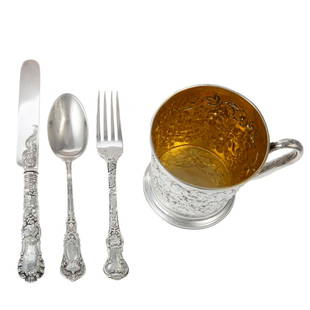
Francis Higgins II, London, 1869, retailed by Hunt & Roskell, New Bond Street, London. In the original fitted case, comprising cup and cutlery set in scrolling grapevine decoration, the cup is monogra

Victorian pieced and embroidered crazy quilt, dated Feb. 15, 1896, with three sets of initials. Stitched with various designs and motifs, predominantly floral sprays. Red velvet border and red wool wi

A Tiffany and Co. Travel Clock and Three Sets of Playing Cards each set of cards with fitted case containing two matching decks. Clock height 2 x width 2 1/4 inches. Property from the Collection of Ro

Contains a vintage Solo-Relide jewelled travel alarm clock with a golf them. A case is made to look like a suit case with golf clubs strapped to the outside. Made in France, circa 1940s. A vintage Phi

Three Carved Victorian Treens. Beautifully Carved from Coquilla and screw top to bottom , first is Pear shaped vanity piece for perfume scents . Scent Bottle hangs from a Chatelaine or a Victorian Wom

THREE ABALONE AND MOTHER-OF-PEARL VICTORIAN CARD CASESEnglish, 19th century. All created of pieced geometric form, the smallest with carved floral design to the diamond medallion set to one side. The

Travel decanter set, c.1900, with three cut glass bottles set in an oak and metal carrying case, felted base, no maker's marks observed to glass or stand, wear consistent with age and use, lacking key

Leather Cased Travellers Cocktail Set, to include a cocktail shaker, three flasks, nest of beakers, bitters bottle, in a fitted leather case, along with a travel bottle with beaker in fitted leather c

United States,19th Century Includes a brass face cribbage board with heart, club, diamond, and spade decorations, a travel cribbage board with inlaid marquetry, a domino set with leather case, and thr

Vintage 3 piece Crystal scent bottle set in red leather case. Comprised of three Crystal bottles, two in triangular shape, one in flask shape. All with threaded brass caps with hand-laid enamels in Re

DESCRIPTION: Three antique travel utensil sets: one featuring long chopsticks and knife housed in a rayskin case, one composed of shorter chopsticks and a knife in a rayskin case, and one lone pair of

Three daguerreotype of 3 Victorian men. One is set in a gutta percha case which is broken at hinges, one is a papier-mache case and one has no case. Daguerreotypes are all in good condition.

second half-19th century; including: silver inlaid case with glass scent bottle, match safe, and cigarette case

Very nice vintage poker chip set in original vintage wood travel case. Set includes approximately 600 poker chips, and cards. Cards are newer and not original to set. Missing key. Case measures approx

The Pen Display Boxes and a Zippered Vinyl Pen Travel Case. Three boxes with glass. Two red vinyl boxes signed Levenger, others unsigned. Red boxes measure 5" H, 12-3/4" L, 7-3/8" D. Condition: Good v

German Cowhide Travel Case with Three Zippo Lighters

PIEDMONT NORTH CAROLINA FEDERAL WALNUT HUNTBOARD / SIDEBOARD, unusual canted form, long trapezoidal two-board top above a conforming case set with three short, lip-molded, dovetailed drawers above two

Bielecky Bros., cane, lucite chests of drawers, c. 1980s, USA, rattan cane-wrapped wood case set with three stacked drawers mounted with brass pulls, raised on a curved lucite base, metal label to top

CHOPARD 18KT YELLOW GOLD AND DIAMOND WATCH Approx. 60.08 total dwt. (No Reserve*) Square case set with three rows of 112 brilliant-cut pave diamonds, approx. 1.60 carats total weight. Four blue sapphi

One Rimmel travel set of three glass perfume bottles in a lined travel box. Interior and exterior of box covered in velvet. With original labels and key for lock. H. 11.5 (4 1/2") W. 18cm(7") One trav


Related Searches
- Search Search

London Flagship Store
Keeping up appearances: the history of the vanity case.

A Globe-Trotter vanity case is the ultimate throwback to a bygone era of luxury. We take a look at the origins of this ornate yet eminently practical travel staple . encapsulating our contemporary designs into developing our modern takes on a travel vanity case .
Makeup vanity cases may be considered a distinctly feminine accessory but, in Britain at least, they were originally designed for men and came into fashion towards the end of the 18th century. Known as ‘dressing cases’, these were finely crafted containers made from luxury materials and finishes with compartments for toiletries such as cologne, shaving cream, combs and manicure tools.
The French, however, were one step ahead when they pioneered the ‘Nécessaire de Voyage’ (sometimes just known as ‘Nécessaires’), which date back to the 14th century. These practical yet highly decorative travel cases were made for royalty and noblemen and gradually became more extravagant in design as travelling requirements evolved. Intricate compartments were designed to transport everything from cutlery to stationery, sewing equipment and even candle holders.
Probably the oldest vanity boxes known to man was discovered by Howard Carter (he of Tutankhamun fame) and is over 3,000 years old. The inlaid cedar box was discovered in a pharaoh’s tomb and contained stone ointment jars, perfumes, face paints and a hand mirror made from polished metal with a wooden handle decorated in gold. Proof, if needed, that man’s desire to look good is nothing new.

Useful though they may be, vanity cases have always been unashamedly decadent in design. This was taken to a whole new level in the 1920s, when women's burgeoning independence (it was now socially acceptable for young ladies to smoke and apply make-up in public) meant that vanity cases had new requirements. Rather than previous bulky models, these new portable kits were sleek and slimline in design according to the Art Deco style. They were made by the eminent jewellery houses of the day, such as Cartier and Van Cleef & Arpels, and featured gorgeous detailing and materials including mother of pearl, tortoise shell, jade and precious stones. Charles Arpels (Van Cleef & Arpels co-founder) came up with the idea after he noticed his friend, American heiress Florence Gould, tossing her lipstick, cigarette lighter, powder and a few banknotes in a Lucky Strike tin. This inspired him to create a slimline vanity case so that a lady could fit all her necessities into one stylish, on-the-go piece of kit.

Vanity cases are still popular today although their style and inexpensive materials (and, ultimately, price points) have made them more of a practical item than a luxury one.
In fact, Globe-Trotter is one of the few companies to handmake portable vanity cases from luxurious materials in the style of the antique models. While a number of vanity case models have been designed for Globe-Trotter since the 1960s, the current version was introduced around the launch of the Centenary collection in 1997, and has since become an integral part of the range.
The Globe-Trotter Vanity Case is 13" in size and features a fitted tray to store jewellery as well as a detachable mirror and three-digit combination lock. Its distinctive box shape mirrors the trunk style and is designed to be used as a travelling set, featuring the same leather corners, straps and vulcanised fibreboard body as the suitcases.
There have been several special-edition Globe-Trotter Vanity Cases released in recent years. Perhaps the most opulent, and therefore truest to its heritage, is the Goring Vanity Case, created in collaboration with the five-star London hotel. It features a regal damask silk lining; the same used in the interior upholstery of HM Queen Alexandra's State Coach, originally built in around 1865.
Free Luggage Tag
Sign up to receive a free handmade luggage tag with your first order and be the first to get exclusive access to new releases, offers and events. T&Cs apply.
Featured items in this article

Safari Vanity Case

Cruise Vanity Case

Centenary Vanity Case
Similar articles – we think you'll love.

125 Years of Globe-Trotter Exhibition

F1 2024 Insider's Guide No. 10 – Spain

Miniature Heroes: Globe-Trotter unveils the Mayfair Case

Worldwide shipping
Complimentary on all orders

Secure payments
For all major credit/debit cards

Up to five years after purchase

Easy returns
Free returns for up to 28 days
Select Shipping Destination
You currently have no items in your bag
The True History of the Orient Express
Spies used it as a secret weapon. A president tumbled from it. Hitler wanted it destroyed. Just what made this train so intriguing?
/https://tf-cmsv2-smithsonianmag-media.s3.amazonaws.com/accounts/headshot/david-zax-240.jpg)
To most people the Orient Express is more an idea than a tangible entity. We are most familiar with its life in fiction and cinema: Hercule Poirot solved his most famous case on it, Alfred Hitchock's lady vanished from it and James Bond rode it from Istanbul to London.
Now, the latest iteration of the legendary train is chugging back to the big screen as director Kenneth Branagh tries his hand at remaking Agatha Christie's classic murder-mystery tale.

But what was the real Orient Express like, how did it first attain its aura of mystery and intrigue and what was the famous train's ultimate fate?
A Continental Vision
In 1865, a prominent Belgian banker's son named Georges Nagelmackers first envisioned "a train that would span a continent, running on a continuous ribbon of metal for more than 1,500 miles," as E. H. Cookridge writes in Orient Express: The Life and Times of the World's Most Famous Train . During a trip to America, Nagelmackers witnessed the many innovations in railway travel there—chief among them George Pullman's unprecedented, luxurious "sleeper cars"—and he returned determined to realize his vision.
In 1883, after a number of false starts, financial troubles and difficulties negotiating with various national railway companies, Nagelmackers's Compagnie Internationale des Wagons-Lits ( wagons-lits being French for "sleeper cars") established a route from Paris to Istanbul, then called Constantinople. The newspapers dubbed it the "Orient Express"—though Istanbul was as far toward the "Orient" as this train would ever travel—and Nagelmackers embraced the name.
On October 4, the Orient Express set out on its first formal journey, with many journalists aboard to publicly marvel at the train's luxury and beauty. (Nagelmackers, a clever showman, even arranged to have shoddy, decaying old Pullman cars stand in contrast on the tracks adjacent to the Express as it left Paris's Gare de Strasbourg.) Aboard the train, the delighted passengers felt as though they'd entered one of Europe's finest hotels; they marveled at the intricate wooden paneling, deluxe leather armchairs, silk sheets and wool blankets for the beds. The journey from Paris to Istanbul lasted a little over 80 hours.
The King of Trains
Some kings traveling onboard the train infamously exhibited very odd behavior. Ferdinand of Bulgaria, scared to death of assassins, was observed locking himself in the bathroom. Belgium's King Leopold II rode the train to Istanbul after making elaborate arrangements to infiltrate a Turkish man's harem. The king of Bulgaria, an amateur engineer, insisted that he be allowed to drive the train through his country, which he did at perilous speeds. Czar Nicholas II demanded that special cars be built for his visit to France, and some decades later the French President Paul Deschanel clumsily tumbled from one of these cars in the dead of night, an event that prompted such ridicule that he eventually resigned.
In its heyday, the train duly earned another nickname: "Spies' Express." Continent-hopping secret agents loved the train, writes Cookridge, since it simply "made their jobs so much easier and their travels much more comfortable." One of the most remarkable of these agents was an Englishman named Robert Baden-Powell, who posed as a lepidopterist collecting samples in the Balkans. His intricate sketches of the forms and colors of butterfly wings were actually coded representations of the fortifications he spotted along the Dalmatian Coast, which served as great aids to the British and Italian navies during World War I.
Though the two World Wars severely limited Orient Express service, a single car played a fascinating symbolic role in both. On November 11, 1918, German officers signed a surrender document in an Allied commander's Wagons-Lits car, which he used as a mobile conference room. The French proudly exhibited the car in Paris until June 1940, when Hitler ordered that it be hauled to the precise spot where the Germans had been forced to surrender 22 years before; there he dictated the terms of French surrender. Four years later, when Hitler's loss seemed imminent, he ordered that the car be blown up, lest it "become a trophy of the Allies once more."
A True Original
What remains of the Orient Express? The pedigree of the train became rather complicated in later years, as Nagelmackers's original line spawned similar ones following slightly different routes, and as other providers began to use the phrase "Orient Express" for promotional purposes. The Direct Orient Express, the Simplon Orient Express (the train Poirot rode), the Nostalgic Orient Express and many others have existed over the years. One descendant of the original Orient Express became rather shabby, crowded and cheap—a disillusioned journalist called it a "roving tenement." Today's Venice-Simplon Orient Express aims for the opulence of the original, and for the right price, a person can still go for a ride in its restored original Compagnie Internationale des Wagons-Lits cars.
But attempts to maintain the old glamour of the Orient Express have largely fallen into self-parody—promoters of the line have encouraged patrons to dress in 1920s garb, and even once staged a murder mystery game during a journey. Writing in 1976 for the Los Angeles Times , one reporter meets a tired and cranky contessa who says, on the trip's last leg, "If there are going to be any murders on this train, it will be the Turk that wakes me up at 5 a.m."
Modern versions of the Orient Express are a far cry from the original that Cookridge lovingly and nostalgically portrays: "Kings and crooks, millionaires and refugees, big-game hunters and smugglers, prima donnas and courtesans traveled on it; tycoons and financiers clinched their deals across its sumptuous dining tables; diplomats, spies, and revolutionaries on board the train moved secretively to their moments of history." The era of such intrigue and excitement aboard the Orient Express is over. But in a world that becomes more connected every day—and one in which there is no shortage of luxury travel—much of Nagelmackers's vision lives on.
The Orient Express became the train of choice for Europe's wealthy and high-born, a rolling symbol of the economic disparities of its age. "Peasants in half-a-dozen countries would pause in their work in the fields and gape at the glittering cars and the supercilious faces behind the windows," writes Cookridge. It came to be called "the King of Trains and the Train of Kings."
Get the latest History stories in your inbox?
Click to visit our Privacy Statement .
/https://tf-cmsv2-smithsonianmag-media.s3.amazonaws.com/accounts/headshot/david-zax-240.jpg)
David Zax | | READ MORE
David Zax is a freelance journalist and a contributing editor for Technology Review (where he also pens a gadget blog).
This website uses cookies
We place some essential cookies on your device to make this website work. We'd like to use additional cookies to remember your settings and understand how you use our services. This information will help us make improvements to the website.

Copy 1/392 – Boxer Ching Hook in fighting stance, 1888
The Boxers of Whitechapel
Lesson at a glance, what do the documents reveal about the inhabitants, teachers' notes, external links, connections to curriculum.
Whitechapel in the late 1800s was an area of overpopulation, industry and crime. With such wide systemic issues it can be easy to lose sight of the experiences of the individuals who lived in the area. This lesson explores the historic environment through the interconnected lives of four individuals who lived in the area during the 1880s. What can the stories of two West Indian boxers, the daughter of an Irish carpet maker and a child born in Whitechapel itself reveal about the challenges and benefits of living around Commercial Street in the Victorian era?
Starter Activity
Look at Source One and Source Two.
These maps cover the area of Spitalfields where our case study individuals lived.
Source One – The Booth Map:
- Can you find Commercial Street, Elder Street and Great Pearl Street (with Little Pearl Street leading off it to the south) on the map?
- What is being represented by the colour key of the map?
- What colours are Elder Street and Great Pearl Street?
- What does the map tell you about the living conditions of these roads?
Source Two – The Ordnance Survey Map:
- What buildings are named on the OS Map? What do they tell you about the area?
- P.H. stands for Public House or Pub, how many can you find in the area?
Sources One and Two:
- What other features can you find on both maps? (Train stations, markets, churches etc.)
- What do these features tell you about the area?
Source Three:
As part of Charles Booth’s research for his poverty map he sent inspectors to accompany police officers on their beats, walking around the streets of London and making notes on their observations. On March 17th 1898 George Duckworth walked with Sergeant French around the area west of Commercial Street before covering the area to the east on the 18th.
- How does George Duckworth describe the area and its inhabitants?
- Highlight the different nationalities and religions you can find mentioned. What does this tell you about the area?
- What occupations are listed?
- How does the description given here compare to your understanding of the area from the maps
Explore the Starter Activity:
Case Study One – Hezekiah Moscow
Source one:.
- What kind of attractions can you see at the East London Aquarium?
- What animals can you see?
- This is situated in the Whitechapel area – can everyone go?
Source two:
- What has Hezekiah Moscow been accused of?
- Does the author agree with the charge? What reasons do they give?
Source three (a) and three (b):
- What is this man’s name and occupation?
- Why do you think these photographs have been taken?
- What can we tell about this man’s life from his photographs?
- What ideas does the photographer suggest by these two photographs of Ching Hook?
Source four:
- What does this document reveal about Hezekiah Moscow and Ching Hook?
- What can you learn about Sam Baxter?
- What else is going on except the boxing match?
- What evidence is there that Ching Hook is a successful boxer?
Add these details to your timeline
Explore the case study:
Case Study Two – Mary Maddin
- What information does this census page reveal about the Maddin family?
- Where have the family migrated from?
- What professions can you see on the page? What does this suggest about the area?
- How old is Mary Maddin in 1881?
- What can you discover about the lives of Hezekiah and Mary Mosocw from this census record? Include as much detail as possible.
- How many rooms do they have? How does this compare to their neighbours?
- What else does the census tell you about the area?
Source three:
- Why is Marian writing to the editor of ‘Sporting Life’?
- What does this suggest about her life at this time?
- Mary has written her name as Marian here, what does this suggest about the tone she is trying to portray?
- Why is Mary in the workhouse?
- What can you learn about her life at the time from this document?
Case Study Three – Eliza Moscow
- What can you learn about Eliza Moscow from this document?
- George Yard School is a ‘ragged’ school. What does this tell you about Eliza’s life?
- Where was Eliza’s previous school according to this document? What might that suggest about her life?
- What can you learn about Mary and Eliza’s life from this document?
- How would you describe their living situation?
- What else can the census tell you about the area?
- What can you learn about Eliza’s life from this document?
Case Study Four – Alexander Munroe
- What can you find out about Alexander Munroe from this document?
- What has happened to Alexander Munroe?
- What does Thomas M’Carthy’s arrest tell you about Whitechapel at the time?
- How long had Alexander lived at the boarding house? What does this tell you about his life?
- What can you learn about the relationship between Munroe and Hewington from these documents?
- How did the landlord react to the event? What does this tell you about Whitechapel at the time?
- What does the nurse say about Alexander’s reaction?
- What occupation does the illustrated Police News give for Alexander? Does this match the other documents?
- Why does an ‘illustrated police news’ exist? What does it tell you about life at the time?
- Does the portrayal match the other reports?
Sources five (a) and five (b):
- What does the document reveal about the relationship between Alexander Munroe and Ching Hook?
- What was the Professional Boxing Association opinion of Alexander?
- How would you describe Alexander’s funeral from the document?
- What does this reveal about his life in Whitechapel?
Whitechapel in London during the Victorian era was an area of industry and mixed opportunity. For several hundred years it had been home to tanneries, foundries and breweries. These are the types of industry that are necessary for the creation of goods for a city but unpleasant to keep close by with smells and sounds that would disturb the upper classes. As the industrial revolution took hold, Whitechapel and the other Tower Hamlets became a hub of immigration with thousands arriving looking for work from England, Ireland and further afield. With docklands to the south and new rail connections to the rest of the country, 1800s Whitechapel became the ideal home for manufacturers and merchants looking to make and sell their wares to the people of London and beyond. However, industry led to overcrowding and jobseekers soon outnumbered available work.
In 1839 the average life expectancy of a labourer in the area of Brick Lane was only 16 years and for tradesmen was 26. Sanitation was poor, pubs and gin palaces were widespread and crime and poverty rates were sky high. By the late 1800s reformers and philanthropists like Charles Booth and George Peabody were taking note of the terrible conditions and creating schemes to address the needs of the poor. Booth’s survey of London went street to street, observing the population and their circumstances and creating a map of London which showed the most poverty stricken areas. Peabody established a model dwellings company and a charitable trust to create affordable housing for those in need. The first such building opened on 29 February 1864 on Commercial Street, Spitalfields and saw 57 dwellings with shared bathing and laundry facilities and nine shops to be run by the inhabitants on the ground floor.
It is the area around Commercial Street, to the immediate east and west, that this resource focuses on by looking at the interconnected lives of four inhabitants. The documents explore the lives of these figures, their employment and living situations, their community and prospects. It is easy to make summarising statements about the situation in Whitechapel using the large scale facts and statistics and forget that the thousands of people living in these areas had full lives beyond the small glimpses in the record. This resource aims to put the facts and statistics into the context of lives on the ground and provide a fuller picture of life in 1880s Whitechapel.
This series of lesson activities uses four case studies of real people who lived around Commercial Street in Spitalfields in the late 1800s. The case studies are based on the lives of Hezekiah Moscow, Mary Maddin, Eliza Moscow and Alexander Munroe. Each case study contains 4-6 documents and all share the following themes:
- Housing and overcrowding
- Poverty and employment
- Immigration and community
- Crime and policing
Students should be encouraged to consider these themes when exploring each case study. They should go on to interpret this evidence, pick up any inferences or see what they can discover about everyday life in the area. A timeline has been provided within our downloadable lesson pack which can be used either for individual case studies or to consolidate the class’s research as a feedback activity. It could be used as a starter or sorting activity, and helps to make sense of the chronology of the documents and the events they portray. A worksheet to consolidate all four case studies is provided. Individual case study fact file worksheets are also provided at the start of each case study within the pack alongside a list of questions to guide students through the documents in relation to each specific individual.
Some general guidance questions on how to evaluate and understand documents are included here, to help students to draw their own conclusions and inferences from the documents. (Teachers may wish to print these out, and discuss them with the students before they look at the sources). All documents are provided with transcripts.
- Find the date on each document
- What type of document is it? (e.g. census entry, witness statement or newspaper).
- Why was the document written?
- What is the document saying?
- Check the meaning of any words you are unsure about.
- Does the document show the writer’s opinions/values?
- Does it have any limitations?
Teachers may want to break their class up into four groups and explore one case study each, or create a series of lessons to piece together the story. Groups should feed back on the different individuals to ensure all students find out about all four figures. The maps and notebooks can be used as an introduction to the area and work as a whole class investigation before the individual case studies. Students could be encouraged to use the map as reference with the documents of their case studies for geographical context within the Whitechapel area.
Teachers could also look at our Victorian Industrial Towns themed collection to explore additional documents which give context on living conditions, health and overcrowding.
Please note, some documents used in this resource contain ideas and language which reflect historical viewpoints and attitudes. Some may be considered offensive. However, we think it important to show them here as accurate representations of the record to help us understand the past.
Activity One:
- Extract of the Booth Map – Maps Descriptive of London Poverty. LSE – BOOTH/E/1/5
- OS London 1:1,056 – Sheet VII.57, Publication date: 1896 – Reproduced with the permission of the National Library of Scotland
- George H. Duckworth’s Notebook: Police and Publican District 7. 1898. LSE BOOTH/B/351
Hezekiah Moscow:
- East London Aquarium Poster © The British Library Board Evan.421
- Shoreditch Observer – 16th February 1884 © The British Library Board, British Newspaper Archive (BNA)
- COPY1/392 Ching Hook, boxer 1888, Ching Hook in private clothes
- Sporting Life Magazine – 6th January 1888 © The British Library Board, BNA
Mary Moscow nee. Maddin:
- 1881 Census – RG 11/1382
- 1891 Census – RG12/275
- The Sporting Life, July 13 1892 © The British Library Board, BNA
- Workhouse Admission and Discharge Records, Tower Hamlets, 1908. London Metropolitan Archives; London, England; Reference Number: STBG/WH/123/044
Eliza Moscow:
- George Yard School. London Metropolitan Archives; London, England; School Admission and Discharge Registers; Reference: LCC/EO/DIV05/GEY/AD/001
- St Josephs School Tower Hamlets London. London Metropolitan Archives; London, England; School Admission and Discharge Registers; Reference: LCC/EO/DIV05/STJOS/AD/002
- 1911 Census RG14 /1463
- 1939 Register RG 101/1698E
Alec Munro:
- 1881 Census, Rochester – RG11/885
- Lloyd’s Weekly Newspaper – 13 September 1885 © The British Library Board, BNA
- Central Criminal Court Depositions CRIM 1/23/2
- Illustrated Police News – 10 October 1885 © The British Library Board, BNA
- Sporting Life – 9 September 1885 © The British Library Board, BNA
- Tavistock Gazette – 18 September 1885 © The British Library Board, BNA
Charles Booth’s London (LSE) – digitised copies of Charles Booth’s map and notebooks – https://booth.lse.ac.uk/
Grappling with history blog – examining boxers and wrestlers in 1880-90s London – https://grapplingwithhistory.com/
Black Boxers and the colour bar – our blog post exploring attitudes towards Black boxers in the 1900s – https://blog.nationalarchives.gov.uk/black-boxers-and-the-colour-bar/
EDEXCEL GCSE History:
- Whitechapel, c1870-c1900: crime, policing and the inner city
- Migrants in Britain, c800–present
- Crime and punishment in Britain, c1000–present
AQA GCSE History:
- AC Britain: Migration, empires and the people: c790 to the present day
Related resources
Victorian industrial towns.
What made them unhealthy?
Black Victorians
How much can documents reveal about the lives of Black people in Victorian Britain?
Crime in Whitechapel
What made Whitechapel an area where the ‘detection’ of murders was ‘very difficult’?
Whitechapel
How can we find out about what Whitechapel was like in 1888?
Workhouse Voices
What did paupers say about the Poor Law?

IMAGES
VIDEO
COMMENTS
Antique French Boudoir Vanity Grooming Toiletries Set Victorian Edwardian 1890s 1910s Travel Kit. (674) $71.06. $78.97 (10% off) Antique Women's Travel Suitcase, with Correspondence & Vanity Sections, Burgundy Leather, Damask Lined, 7 pc. Tortoise Lucite Vanity Set.
Antique Box, Victorian Vanity Set, Victorian Travel Case, Beveled Glass Mirror, Victorian Collectible Decor (200) $ 84.00. FREE shipping Add to Favorites Eiffel Tower Cigarette Case Wallet Business Card Holder victorian Paris (5.4k) $ 14.99. Add to Favorites Antique Victorian Tan Leather Travelling Jewellery Case - Wonderful example for all of ...
Victorian Travel Bags CARPET BAG 'The old-fashioned carpet bag (Fig. 1) is still unsurpassed by any, where rough wear is the principal thing to be studied. Such a bag, if constructed of good Brussels carpeting and unquestionable workmanship, will last a lifetime, provided always that a substantial frame is used.' ... Victorian trunk case ...
Check out our antique victorian travel case selection for the very best in unique or custom, handmade pieces from our jewelry boxes shops.
This Victorian necessaire de voyage, or traveling case, was made c. 1870 - roughly a century after the French version - and in that hundred years, a lady's personal necessities increased dramatically.Fashioned from patterned coromandel wood and brass, with brass locks and fittings, this box is much larger (34cm wide x 20cm high x 24cm deep) and contains many more items.
Antique Travel Case. Priced £150 to £3,400. Unlock the past with this exquisite collection of antique travel case . Discover compartments, drawers, intricate carvings, and timeless charm. Home > Antique Travel Case > Page 1. PAGE 1 OF 2.
The beautifully polished goncalo alves case has a wonderful age-related patina and a key... Category Antique 1820s Regency Desk Sets. Materials. Wood. View Full Details. ... Victorian leather travel desk purchased in the late 19th century in Bath, England (see attached. Category Antique Late 19th Century English Victorian Desk Sets.
The Vanity Case Company is dedicated to enhancing the female identity through luxurious, 100% handcrafted in Britain, travel cases and accessories that reflect who you are. ... typifying wealth and social standing within contemporary society. During the latter Victorian era, as men's travel cases became more masculine, and women's travel ...
Get the best deals on Victorian Vintage Bags, Handbags & Cases when you shop the largest online selection at eBay.com. Free shipping on many items | Browse your ... Antique 1800s Victorian Carpet Bag Carpetbag Carrying Travel Case 1866 Tapestry* $347.97. Was: $579.95. $19.95 shipping. 40 watching. Vintage Antique Petit Point Floral Art Deco ...
This is an antique touring hat box. A French, leather and brass travel case, dating to the early Victorian period, circa 1850. Superb bombe hat box with fine French travel appeal Displays a desirable aged patina and in good original order Rich caramel tanned leather nicely patinated, commensurate with age Accentuated with pinned brass borders to case edges grasp the tapering frame Dressed with ...
Traveling costumes were simple, warm and practical in the Victorian and Edwardian era. Beige colors were worn for travels by coach, while dark dresses were worn on sea voyages. About Victorian and Edwardian Traveling Costumes 1859 traveling dress: 'Straw hat plainly trimmed with ribbon. Dress of the thinner species of poplin, or any desired material. … Continue reading Victorian And ...
Check out our ladies victorian travel case selection for the very best in unique or custom, handmade pieces from our toiletry kits & travel cases shops.
Check out our victorian vanity travel case selection for the very best in unique or custom, handmade pieces from our toiletry kits & travel cases shops.
Antique Victorian Travel Case Dressing, Jewellery Box. £110.00. or Best Offer. £10.00 P&P. Click & Collect. Antique Victorian Coromandel Ladies Dressing Box Silver Set Jewelry Travel Case . £595.00. or Best Offer. £10.00 P&P. 33 watching. Click & Collect. Stunning Antique Coromandel Jewellery box Brass Detail Professionally Restored. £175.00.
Victorian travel case with set of three scent bottles. Three blown and cut glass bottles with painted gilt borders. E... on May 08, 2009
Vanity Case. $1,645. A Globe-Trotter vanity case is the ultimate throwback to a bygone era of luxury. We take a look at the origins of this ornate yet eminently practical travel staple. encapsulating our contemporary designs into developing our modern takes on a travel vanity case. Makeup vanity cases may be considered a distinctly feminin.
Victorian Train Travel Times. In 1956, the 789-mile Madras-Bombay stretch was done in c. 29 hours by the Madras Express mail carrier (the fastest train on its route). That's about 27 mph. ... In the case of more complicated world travel I based my calculations on the approximate speed of trains in the 1890s, combined with those of late pre ...
Travel Case Toilet Bag Hanging Organizer Black Lace. $44.50 $ 44. 50. FREE delivery Fri, May 17 . Only 1 left in stock - order soon. More results. Victoria's Secret. Beauty Cosmetic Makeup Bag (Pink) 5.0 out of 5 stars. 11. $29.99 $ 29. 99. FREE delivery May 14 - 16 . Only 19 left in stock - order soon.
Georges Nagelmackers, creator of the Orient Express, envisioned "a train that would span a continent, running on a continuous ribbon of metal for more than 1,500 miles," writes one historian ...
merits of Victorian travel accounts with those of twentieth century post-1917 writers that the great qualities of the Victorians stand out. of long and quite close observation of the Russian scene, the curtain. dropped after the outbreak of the First World War, and it has only. raised since then.
This series of lesson activities uses four case studies of real people who lived around Commercial Street in Spitalfields in the late 1800s. The case studies are based on the lives of Hezekiah Moscow, Mary Maddin, Eliza Moscow and Alexander Munroe. Each case study contains 4-6 documents and all share the following themes: Housing and overcrowding
Check out our victorian travel case selection for the very best in unique or custom, handmade pieces from our jewelry boxes shops.
Check out our travel jewelry case victorian selection for the very best in unique or custom, handmade pieces from our jewelry boxes shops.
The French invasion of Russia, also known as the Russian campaign ( French: Campagne de Russie) and in Russia as the Patriotic War of 1812 ( Russian: Оте́чественная война́ 1812 го́да, romanized : Otéchestvennaya voyná 1812 góda ), was initiated by Napoleon with the aim of compelling the Russian Empire to comply with ...